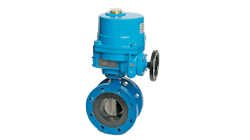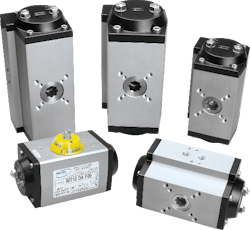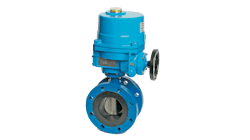A valve actuator is defined as a mechanism that opens and closes a valve. By definition it seems simple but in reality there is nothing simple about them.
There are two basic valve operating designs, linear and rotary. Therefore, basic actuator designs are linear, rotary and sometimes rotary linear. Typically, rotary operated design valves provide the best overall value in valve automation.
Valves that need to be opened, closed or throttled frequently are popular candidates for pairing with an actuator. Actuators are attached or built into a valve body to automatically adjust the flow of fluids, gases, steam, solids or slurries through a valve.
There are many things to consider before selecting the ideal one. First, there are several types of actuators, pneumatic, electric, water hydraulic, oil hydraulic and self-contained electro-hydraulic (oil). The two most often used types of actuators are pneumatic (air) and electric. These technologies are very different and understanding the benefits and limitations of each one is critical.
In general, it important to consider the application, location and intended functionality. Throughout this article we explore the benefits of the two most popular actuator types: pneumatic and electric.
Pneumatic Actuators
Pneumatic actuators typically provide high force and speed in a smaller footprint depending on available air pressure supply than electric actuators. The force and speed of these actuators are semi-independent from each other, the greater the force required, the larger the actuator size and therefore, they have slower operating speed ranges. These ranges are adjustable with air throttling mechanisms to accommodate different speed requirements.
There are several different designs of pneumatic actuators including diaphragm and piston-cylinder types for both linear and rotary valve operating designs. Rotary actuators have the most variety of designs. Piston-cylinder designs include scotch yoke, rack and pinion and modified scotch-yoke. Secondly, there are also vane and diaphragm type rotary designs. All of these provide air to open air close function.
With the addition of a spring or springs, a fail position on the loss of air supply can be provided. An electric solenoid valve is usually required to allow the actuator to shift air supply from open to closed and vice versa.
An important factor when determining price is the added compressor cost and added air tubing to each actuator cost. Although, pneumatic actuators are significantly less expensive in terms of upfront costs, they are most economical when appropriately matched with compressor size. Small compressors are economical only when they are used to power a small number of actuators. The same is true with larger compressors. Unused compressor capacity can be a waste of money therefore it is encouraged to only use a larger compressor when there is a need to power many pneumatic actuators.
Although initial pneumatic unit actuator price is considerably lower, compressor costs, tubing and solenoid wiring costs, maintenance and operating costs can be higher overall. These costs include replacing components that commonly wear out over time, like actuator cylinders, and paying for the electricity it takes to power compressors, which eventually adds up to more cost than most would expect. If there is already is a compressor at your facility and the unit has capacity, then a pneumatic actuator can be a great value.
Electric Actuators
Electric actuators, also known as electric motor operators, are known for their precise control and positioning capabilities. Typically, they can be heavier but because of what it takes to achieve that precision, they can be substantial in cost. The accuracy comes from the high quality components. High precision screws and anti-backlash mechanisms can create positioning accuracy to ten thousandths of an inch and even standard components can generate exactness to a few hundredths or thousandths of an inch.
Electric actuators tend to not have the speed and thrust associated with pneumatic due to the nature of electric motors. Thrust must be sacrificed to achieve high speeds and vice versa. For any electric actuator, more thrust is available only at low speeds and less thrust will be offered at high speeds. Because of this, initial sizing of electric actuators is extremely important. If a thrust or speed increase is needed after installation, it will require replacing with a larger and more powerful actuator.
When choosing to go electric, make sure to understand its application in real conditions under load. With electric actuators, the cost between different sizes increases exponentially, so understanding specifications of the system will help in choosing the right actuator while minimizing cost.
One area operators see lower costs with electric actuators is in operating expenses. Operating costs for these units come mostly from the power draw of the motors. When calculating cost versus benefit between pneumatic and electric, look past initial cost and remember to factor in operating time and costs, too.
Other Considerations
It is important to keep in mind, environmental regulations are getting tighter each year and strict emission laws are frequently being put in place. Electric actuators are currently gaining popularity because they do not require the use of supply gas and do not emit emissions. Installing a vapor recovery unit or using compressed air help cut down on emissions associated with pneumatic actuators.
Another case for electric actuators is automation. A significant benefit with electric actuators is they can control your valves from an offsite location. Automation is also possible with pneumatic, but by only using an I/P valve controller which converts an electric signal to pneumatic. Ultimately adding another component to buy and maintain.
If it is time to replace actuators or if purchasing them for the first time, take some time to consider the system and the exact role the actuators will serve. Consider future expansion and the overall budget. And of course, always ask reputable experts for recommendations.
About the Author
Laura Jensen
Marketing Communications Specialist
Laura Jensen is marketing communications specialist for Flomatic Valves. Jensen can be reached at [email protected].


